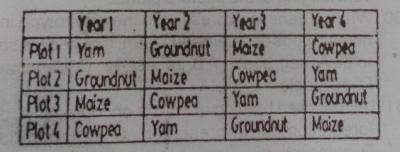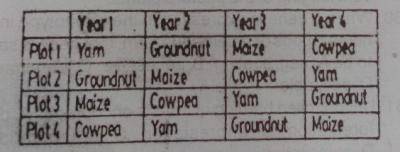Year :
2020
Title :
Agricultural Science
Exam :
WASSCE/WAEC MAY/JUNE
Paper 1 | Objectives
11 - 20 of 50 Questions
| # | Question | Ans |
|---|---|---|
| 11. |
Water which rises above the water table in the soil and is held in fine medium pores between soil particles by surface tension is? A. hygroscopic water B. gravitational water C. capillary water D. percolating water |
C |
| 12. |
An oven dried soil sample of mass 8g had a mass of 1.6g after it was completely burnt. Determine the percentage of humus in the soil sample. A. 6.4% B. 9.6% C. 20% D. 80% |
D |
| 13. |
The deficiency of nitrogen in a maize plant can be corrected by applying? A. potassium chloride B. muriate of potash C. sulphate of ammonia D. calcium carbonate |
C |
| 14. |
The structure of sandy soils can be described as? A. platy B. crumby C. single-grained D. bloc |
C |
| 15. |
 The cropping system illustrated in the table is? A. mixed cropping B. crop rotation C. shifting cultivation D. land rotation |
D |
| 16. |
 Which of the following crops can conveniently replace maize in the table? A. cassava B. cashew C. mango D. millet |
D |
| 17. |
The following bacteria are important in the nitrogen cycle except? A. bacillus B. nitrobacter C. nitrosomonas D. rhizobium |
D |
| 18. |
Determine the ratio of nutrients in NPK 5-10-15. A. 1:2:2 B. 1:2:3 C. 1:3:1 D. 2:1:3 |
B |
| 19. |
Which of the following methods of irrigation is most efficient in terms of water conservation? A. flood irrigation B. furrow irrigation C. border irrigation D. drip irrigation |
D |
| 20. |
Which of the following crops is dicotyledonous? A. Zea mays B. Oryza sativa C. Elaeis guineensis D. vigna unguiculata |
D |
| 11. |
Water which rises above the water table in the soil and is held in fine medium pores between soil particles by surface tension is? A. hygroscopic water B. gravitational water C. capillary water D. percolating water |
C |
| 12. |
An oven dried soil sample of mass 8g had a mass of 1.6g after it was completely burnt. Determine the percentage of humus in the soil sample. A. 6.4% B. 9.6% C. 20% D. 80% |
D |
| 13. |
The deficiency of nitrogen in a maize plant can be corrected by applying? A. potassium chloride B. muriate of potash C. sulphate of ammonia D. calcium carbonate |
C |
| 14. |
The structure of sandy soils can be described as? A. platy B. crumby C. single-grained D. bloc |
C |
| 15. |
 The cropping system illustrated in the table is? A. mixed cropping B. crop rotation C. shifting cultivation D. land rotation |
D |
| 16. |
 Which of the following crops can conveniently replace maize in the table? A. cassava B. cashew C. mango D. millet |
D |
| 17. |
The following bacteria are important in the nitrogen cycle except? A. bacillus B. nitrobacter C. nitrosomonas D. rhizobium |
D |
| 18. |
Determine the ratio of nutrients in NPK 5-10-15. A. 1:2:2 B. 1:2:3 C. 1:3:1 D. 2:1:3 |
B |
| 19. |
Which of the following methods of irrigation is most efficient in terms of water conservation? A. flood irrigation B. furrow irrigation C. border irrigation D. drip irrigation |
D |
| 20. |
Which of the following crops is dicotyledonous? A. Zea mays B. Oryza sativa C. Elaeis guineensis D. vigna unguiculata |
D |